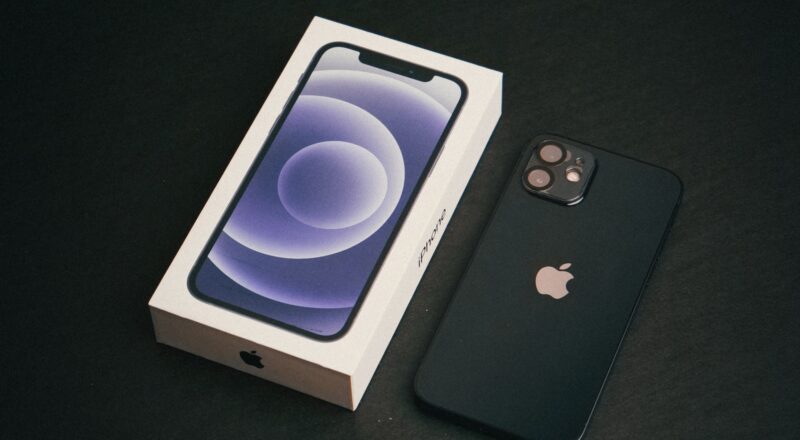Apple iPhone 13: Apple Gives a Delightful Upgrade at Fair Value
In September 2021, Apple introduced the Apple iPhone 13 series as the successor to the iPhone 12 series. The iPhone 13’s display is superior, with a smaller notch, and it also features a better camera and longer battery life. Could this be the most significant change to the iPhone 12? Let’s investigate this further.
Design
Apple has consolidated the FaceID flood illuminator and dot projector into a single component and shifted the earpiece cutout to the top of the phone to make the notch on the iPhone 13 series smaller than on previous models. Its f/2.2 aperture and 12MP TrueDepth front camera remain unchanged.
There have been no changes to the button layout since the Apple iPhone 12. Therefore, you’ll find the Ring/Silent button adjacent to the volume controls. Since the phone’s metal frame has a matte appearance, fingerprints won’t stick to it as readily as they would on a shiny surface. The phone comes with antenna cutouts.
You’ll find the volume rocker and the mute switch on the top, while the lightning port is at the base and the speaker grille and microphone jack are on the left and right, respectively. The phone is protected for up to 30 minutes from water submersion at a depth of 6 meters with an IP68 certification.
You can’t put an iPhone 12 cover on an iPhone 13, despite having the same 6.1-inch screen. This is because the iPhone 13 is slightly thicker (7.65mm vs. 7.4mm), and the iPhone 12’s camera hump is somewhat less (3.5mm vs. 3.8mm).
Corning tempered glass keeps the edges sharp while providing protection. Colors include Pink, Blue, Midnight, Starlight, and Red. However, it weighs 10 grams more than the iPhone 12 at 173 grams due to the larger battery.
Display
The iPhone 13 retains an identical 6.1-inch OLED Super Retina XDR display with a 2340 x 1080 resolution and 476 ppi. Supporting both High Dynamic Range and Dolby Vision, the company claims the display is 28% brighter outside at 800 nits, with peak brightness for HDR reaching 1200 nits. Wide color support and True Tone controls are included. In addition, a Taptic Engine allows for haptic touch feedback.
You’ll have to settle with an older iPhone if you require a high refresh rate screen but can’t afford the Pro model. A new kind of protection, the Ceramic Shield, was first seen on the iPhone 12. Apple claims that the new high-temperature crystallization method, which creates nano-ceramic crystals inside the glass matrix, provides 4x greater drop performance compared to conventional protection.
Camera
Apple claims that the iPhone 13’s 12MP (f/1.6) primary camera, which has 1.7 m pixels, is the largest sensor ever used in an iPhone dual-camera setup. In addition, sensor-shift optical image stabilization, first seen in the iPhone 12 Pro Max, has been included in the primary camera of the iPhone 13 and iPhone 13 Plus. The secondary camera is a 12-megapixel, 120-degree ultra-wide (f/2.4) lens.
Every camera has a Night Mode that you can adjust manually for maximum detail. A night mode symbol will appear when your phone senses dim lighting. In addition, you can adjust the lengthy exposure up to 30 seconds, which is suggested automatically. Like the iPhone 11 series, it also has Apple’s Deep Fusion feature. This takes advantage of the state-of-the-art image processing system powered by the A15 Bionic Neural engine, which allows for capturing photographs with much-improved texture, detail, and noise reduction, even in low light.
The camera interface is the same as previous models, with options including picture, video, portrait, panorama, timelapse, slow-mo, and the brand-new cinematic mode. In addition, you may now use the Photographic Styles filters on your pictures. Finally, while the RAW mode is absent on the iPhone 13, you can get that capability via expensive third-party programs.
All of the iPhone 13 variants have a Cinematic mode that includes a depth effect and auto-focus shifts. In addition, photos, iMovie on iOS, iMovie on macOS, and Final Cut Pro allow you to tweak the focus before and after shooting and customize the bokeh effect.
Cinematic mode captures in Dolby Vision High Dynamic Range. In addition, the gadget supports HDR video recording with Dolby Vision at every stage of the workflow, from shooting to post-production, with resolutions up to 4K at 60 frames per second.
Software
iPhone 13 debuted with iOS 15 preinstalled. However, since then, Apple has updated iOS 15.0.1 and iOS 15.0.2 to address bugs, as well as iOS 15.1, which brings the much anticipated SharePlay feature, allowing users to watch and share material with others over FaceTime.
The latest version of iOS includes improvements to FaceTime, such as Spatial audio, Voice Isolation, Portrait mode, and more. Using the Grid View, you may see up to six people at once in a grid during Group FaceTime chats. In order to communicate with those who don’t have FaceTime, you may now create a custom link that will open on a web page, making it accessible even to Windows or Android users.
Focus mode, available throughout the Apple ecosystem, is a novel approach to filtering alerts depending on what the user wishes to focus on “at that time,” whether it is Work Focus, Personal Focus, or Fitness Focus. In addition, in iOS 15, a new program called notification summary has replaced notifications, and the Live Text function now works with on-device intelligence.
Connectivity
The iPhone 13 only has one physical SIM card slot, but it supports eSIMs, so you can use an eSIM as a second SIM card if you need it. In addition, it supports both Gigabit-class LTE and 5G (below 6 GHz).
Battery
The iPhone 13’s battery is 15% larger at 3227mAh than the iPhone 12’s battery at 2815mAh. Apple advertises that the iPhone 13 can play videos for 19 hours on a single battery. In addition, it can be charged wirelessly from 0% to 100% in about 2.5 hours when using an Apple MagSafe charger, which is a significant improvement over the 3 hours required by its predecessor.
Performance
The A15 Bionic 5nm Chip is what drives the iPhone 13, and it has approximately 15 billion transistors, up from the A14 Bionic’s 11.8 billion. The business claims that its new 6-core CPU is 50% quicker than the competition and the fastest in any smartphone. The CPU is divided into two high-performance cores and four high-efficiency cores.
Conclusion
The iPhone 13 is a significant improvement over the iPhone 12. The battery, performance, and camera have all been improved, even if the overall design and functionality remain the same. In addition to the ability to use the phone for a long time without needing to buy a new model, Apple provides five years of OS updates.
Read more:Apple iPhone 13 Pro Max

